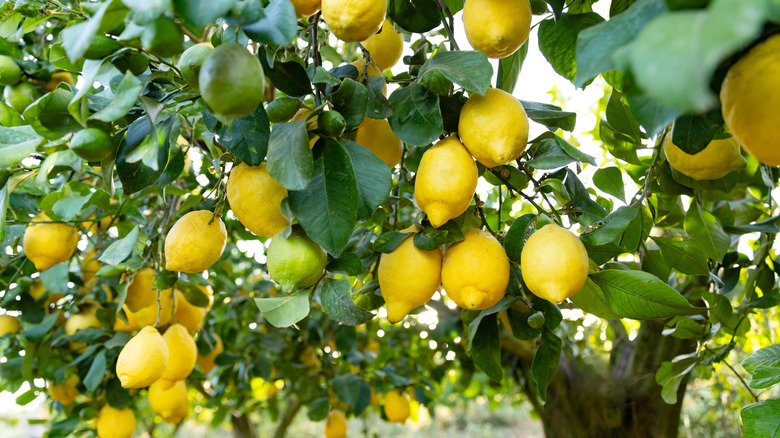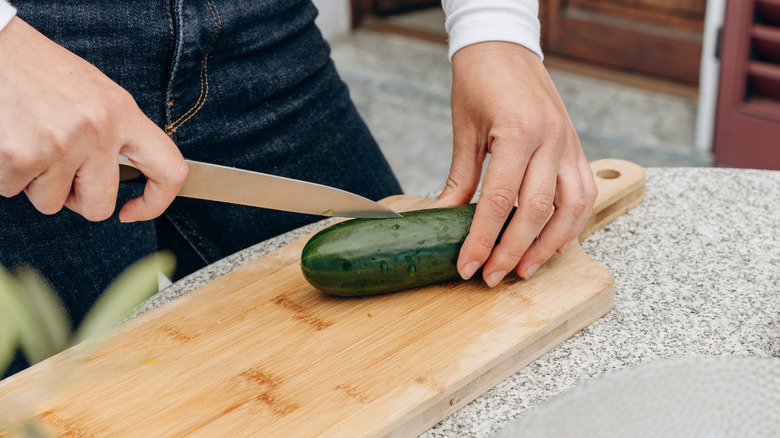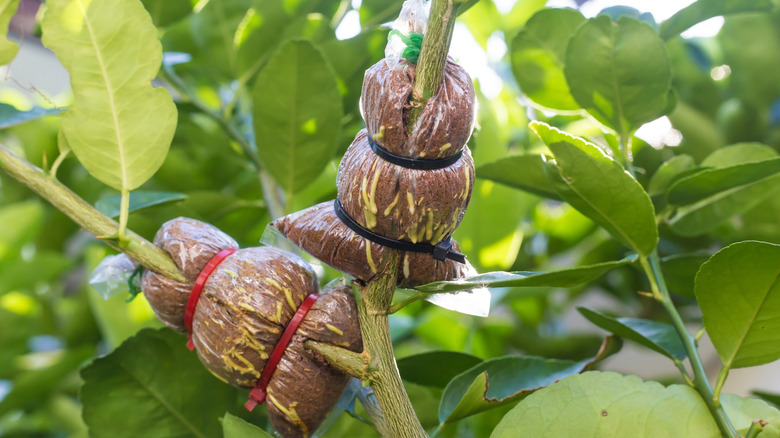The Popular Lemon Tree Hack Experts Actually Warn Against
Propagating is a great and affordable way to get more plants. If you have a lovely lemon tree and would love to have more but are on a budget, then you may be interested in propagating your lemon tree. A common method is called air layering, and it involves wounding a healthy plant stem and wrapping the lesion in sphagnum moss or soil and keeping the moss or soil moist while new roots develop. Wrapping the soil in plastic is an innovation that makes this process much more likely to succeed. You can even learn how to use aluminum foil to make layering plants in the garden a breeze. Another popular trend has been on the rise, and it involves adding a cucumber into the mix. However, it may actually do more harm than good.
For this propagation trend, after scoring the tree, you would take a cucumber, cut off the ends, and slice it in half lengthwise. Then, remove the seeds from the middle so that the cucumber can be wrapped around the lemon tree stem. After using toothpicks to keep the cucumber in place, you would place a plastic cup full of soil around the cucumber, taping the cup in place. Finally, you water the soil in the cup and wrap the whole contraption in a plastic bag. While this is similar to regular air layering and sounds like it could even be an improvement, introducing the cucumber is unnecessary and can increase the potential for infections in your lemon plant.
Why experts say you should not try this hack
Although adding a cucumber into the mix may seem like a good way to add more nutrients, it is more likely to introduce harmful bacteria to your lemon tree than it is to benefit the process. Just like bacteria and pathogens can enter wounds on your skin and cause infections, bacteria and pathogens can enter tree wounds. For this reason, it is important to use a sanitized blade when scoring the tree and sterile rooting media. If the tree's wound becomes infected, it may fail to produce roots. Cucumbers are susceptible to all kinds of pathogens, fungi, and bacteria, and exposing your lemon tree's lesion to a cucumber that may be hiding any of these contaminants is a recipe for disaster. Plus, the usual recommendations on how to use air layering to propagate a plant do not involve any kind of additive. It is really not necessary to achieve a successful propagation.
If you want to add something more to your air layering, then perhaps applying a hormone rooting compound to the wound is a better idea. Rooting hormones are a better way to encourage root growth during air layering propagation. Simply apply it to the wound at the same time the trend suggests adding the cucumber, which is before covering with soil. Alternatively, you can simply follow the common, tried-and-true method for air layering propagation for your lemon tree and leave out all of the optional additional elements.
How you should propagate your lemon tree instead
To successfully propagate your lemon tree using the air layering technique without exposing your tree to unnecessary risks, you can follow more conventional air layering methods. In the fall or spring, search for healthy stems that are a couple of years old and free from the common diseases you should know about before growing lemon trees. Using your sterilized knife, clear a section of the stem from any shoots and leaves. Next, carve two parallel lines all the way around the stem. They should be approximately 1.5 inches apart. Cut a line to connect the two parts and peel off the outer layer between the two parallel cuts. Gently scrape away the green tissue beneath the outer layer. Then, wrap the wound in damp peat moss until the wrapping is about 3 to 4 inches thick. If you want to apply rooting hormone to the cut area, do so before adding the peat moss. Contain the peat moss by wrapping it with polyethylene film, and secure the polyethylene film with twine, weatherproof tape, or zip ties.
Check the peat moss regularly to ensure that it is moist, and eventually, roots should begin to show through the moss. Once the roots visible through the moss look strong, you can remove the polyethylene film and moss. Cut through the stem right below the rooted section, and your new lemon tree propagation will be ready to plant and survive on its own. If it is small enough, you can even learn how to grow your lemon tree indoors.


